Numerical Study of Film/Shock Interaction on Suction Surface of Transonic Turbine Cascade*
Kang Huang Di-yun Chen Shi-feng Li Pei-jie Shi Hu-sheng Ma
(Aerospace Technology Institute,China Aerodynamics Research and Development Center)
Abstract:The interaction between the cooling film on the suction surface of the transonic turbine cascade and the shock wave in the passage is analyzed by numerical calculation method.The effects of cooling pressure and incident angle on the shock wave shape and the film cooling efficiency under the action of shock wave are studied.The results show that with the increase of exit Mach number,the incident position of the left shock wave at the trailing edge of the cascade moves backward relative to the leading edge of the adjacent cascade,and the shock wave intensity increases;there is a temperature jump behind the temperature peak at the exit Mach number of 1.05 and 1.2,the main reason is that with the increase of shock wave intensity,the interaction between shock wave and boundary layer intensifies,and the boundary layer appears local separation,in the separation region,the mixing of high-temperature mainstream and boundary layer flow intensifies,which makes the temperature in the separation region of suction surface increase;the results show that different cooling gas injection positions have great influence on the shock wave shape in the channel,and the cooling area of the wall is smaller than that before and after the shock wave,which is mainly due to the reduction of the film coverage area under the impact of the incident shock wave,after the impact zone of shock wave,the cooling film is compressed by the main stream and attached to the wall again,resulting in the discontinuous film coverage at the shock wave incident point;the film cooling efficiency decreases significantly with the increase of cooling flow angle from 25°to 35°and changes little with the increase of cooling flow angle from 35°to 45°;the cooling efficiency does not increase infinitely with the increase of blowing ratio,when the blowing ratio is greater than a certain value,the influence of blowingratio on cooling efficiency gradually decreases.
Keywords:Transonic Turbine;Suction Surface;Film Cooling;Shock Wave
1 Introduction
With the increasing demand for thrust to weight ratio of aero-engine,turbine components develop towards high load and high efficiency,and the Mach number of turbine outlet increases gradually.Taking high pressure turbine as an example,it has developed from the early all subsonic stator and rotor blades to the present super/ transonic stator or rotor blade row,and is developing towards all super/transonic stator and rotor blades.It is found that there is a serious shock wave phenomenon in the super/ transonic turbine passage,that is,the complex shock wave system structure in the super/ transonic turbine cascade passage will bring shock loss and shock/ boundary layer interference loss that can not be ignored[1-8].In addition,with the increase of turbine aerodynamic load,its thermal load is also increased sharply.In order to cope with the increasing thermal load of turbine blade,a large number of cooling structures are arranged on the turbine blade,which leads to significant shock wave/ cooling gas interaction phenomenon in transonic turbine.
In the aspect of shock/ cooling gas interaction in turbine cascade channel,a lot of exploratory research work has been carried out by researchers at home and abroad.Mose[9]et al.studied the loss caused by film cooling on the pressure surface of transonic turbine cascade.The two-dimensional flow of transonic turbine cascade was simulated experimentally.The outlet Mach number changed from 0.7 to 1.4,and the blowing ratio changed from 0 to 1.7.The loss problem of cascade flow was studied experimentally.The results show that the injection of cooling air has little effect on the flow loss.Sieeverding[10-15]et al.have carried out a series of experimental research on the trailing edge cold air injection of transonic turbine cascade.The research shows that with the trailing edge cold air injection entering the mainstream,the bottom pressure increases at the beginning,and then decreases with the increase of cold air flow.The maximum bottom pressure under cold air injection is greater than that without cold air injection.Kapteijn [16] et al.studied two different trailing edge cold air injection structures of a high-pressure turbine guide vane plane cascade,and found that the two kinds of cold air injection structures have little effect on the bottom pressure,but the flow loss caused by the semi split cold air injection mode is significantly increased,and the semi split cold air injection mode also produces a large flow turning angle.Saracoglu [17] have conducted in-depth research on the influence of different trailing edge cooling jet flow and steady/ pulse jet on shock wave.The surface continuous jet divides the low pressure region into two parts,the vortex street is divided into two rows,and the oblique shock wave weakens and the frequency of Carmen vortex street changes.It is confirmed that the shock loss can be reduced by controlling the trailing edge cooling jet reasonably.Rajendra [18] also studied the effect of trailing edge cold air injection on the aerodynamic performance of turbine cascade.Pascal[19]of Aachen University of technology in Germany studied the interaction of shock wave and film cooling in supersonic flow field,and the results showed that the film cooling efficiency and the flow near the film hole changed significantly under the shock wave.Takeshi [20] et al.Carried out experimental research on the flow characteristics of flat plate film cooling under shock wave,and obtained the shock wave system structure under shock wave/film interaction.Peng Wei and Jiang Peixue[21-22]of Tsinghua University have numerically analyzed the influence of shock wave on the adiabatic efficiency of supersonic film cooling of flat plate model.
Most recently,Li Ziqiang [23] using infrared temperature measurement technology studied the effects of film cooling hole arrangement,gas inlet angle,blowing ratio and temperature ratio on the cooling characteristics of the impingement-film cooling shroud.Cunliang Liu [24] using the Pressure-Sensitive Paint (PSP) measurement technique studied the film cooling effectiveness of two turbine blades at different turbulence intensities and mass flux ratios.Fu Zhongyi[25] investigated the effect of mainstream turbulence on the three-dimensional distribution of the full coverage film cooling effectiveness for two enlarged actual twisted vanes with cylindrical or shaped holes.Feng Li[26] using numerical method predicted the phantom cooling on the blade tip and casing from blade-surface film coolant.Seralathan[27]investigated the film cooling performance of the laidback fan shaped holes.It can be concluded that laidback fan shaped hole provides a better lateral spreading of the ejected coolant and improved film cooling.Jian Liu[28]using compound angle holes in staggered arrangement to control the jet holes coolant coverage upstream of the LE region,and six different arrangements of cooling holes are designed,with variations from one row or two rows arrangements,parallel or staggered arrangements,normal cylindrical holes or compound angle holes.Chunhua Wang[29] using infrared thermography experiments and large-eddy simulation studied trench film cooling on C3X vane model at the mainstream Reynolds number of 2.×105based on the chord length,and nominal blowing ratios of 0.5 and 1.5.Cunliang Liu[30] using the Pressure Sensitive Paint (PSP) measurement technique studied the film cooling effectiveness of two turbine blades at different turbulence intensities(0.62%and 16.00%)and mass flux ratios(2.91%,5.82%,8.73%and 11.63%).
Although researchers at home and abroad have carried out a large number of studies on shock wave/cooling gas interaction of transonic turbine cascade,the previous literature mainly focused on the interaction of trailing edge cooling gas and pressure surface cooling gas with shock wave,and the literature on the interaction of suction surface film/shock wave is less,The film/ shock interaction on the suction surface is more and more common,so it is necessary to study the cooling film/shock interaction on the suction surface.
2 Numerical calculation Model
2.1 Physical Model and Computational Grid
In order to study the phenomenon of the shock wave and gas film interaction on the suction surface of transonic turbine blade,a transonic turbine blade cascade shape is selected as the research object,and the flow interaction mechanism between shock wave and gas film is studied by numerical calculation method.
The blade profile diagram is shown in Figure 1,the calculation domain and comparison of different grid schemes is shown in Figure 2.It can be seen that there is little difference between the results of the four grid schemes.The 6.64 million grid scheme if selected for this calculation.By setting periodic boundaries in the pitch direction and spanwise direction,only the flow of a single cascade channel in the limited blade height range is simulated to reduce the computational complexity.In the cascade pitch direction,the distance between the two boundaries of the computational domain is one cascade pitch distancet;The axial distance from the leading edge of the blade to the inlet section of the computational domain is one time of the chord lengthl;The axial distance of the exit section from the trailing edge of the blade profile to the exit section is 4 times of the axial chord length.The unstructured grid is used,and the boundary layer and gas film hole area are densified.
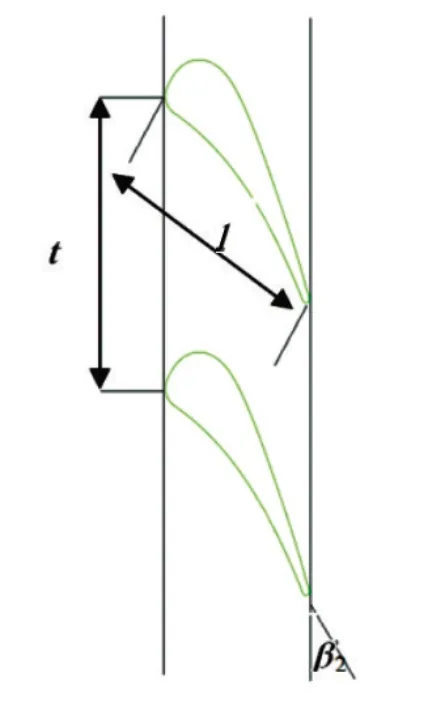
Fig.1 Cascade geometry parameters
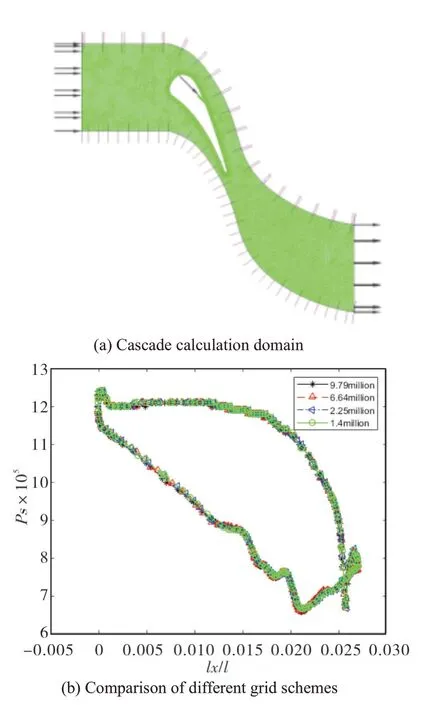
Fig.2 Cascade calculation domain and comparison of different grid schemes
2.2 Boundary Conditions and Solution Settings
The inlet boundary condition of the computational domain is given by the total temperature and total pressure,the incoming flow is undisturbed,and the inlet air angle is zero;the pressure boundary is adopted at the outlet to ensure that the is entropic Mach number is 1.05.In order to reduce the numerical reflection effect of the pressure outlet boundary,the distance between the outlet boundary and the trailing edge of the blade profile is 1.5 times of the axial chord length.In addition,the blade surface is set as adiabatic non slip wall surface;two boundaries in the pitch direction and two boundaries in spanwise direction are set as periodic boundaries respectively.SST turbulence model is selected in this paper.
2.3 Validation of Turbulence Model
In this paper,the run107condition of C3X experiment in reference[31] is selected to verify the numerical calculation model of transonic cascade flow involved in the research process of this paper.The boundary conditions are set as follows: inlet total pressure 107355Pa,inlet total temperature 798K,inlet turbulence 6.5%,outlet static pressure 51691Pa.Figure 3 shows the comparison between the calculated and experimental results of pressure distribution on blade surface.It can be seen from the figure that the calculated pressure distribution curve has little difference with the experimental value,especially the calculated value of the pressure surface is in good agreement with the experimental value,but the calculated value at the lowest value of the suction surface is different from the experimental value,but the trend is in good agreement,which indicates that the numerical calculation model established in this paper can carry out the trend comparative analysis of various schemes.
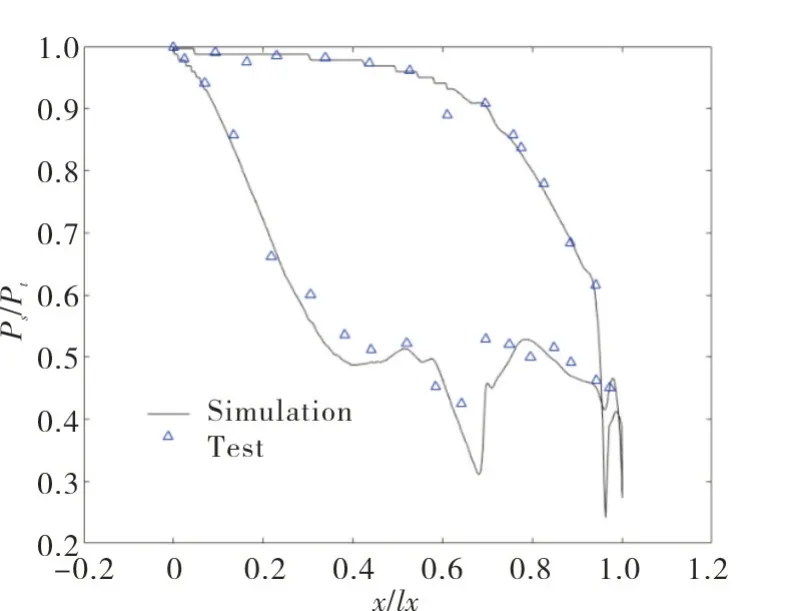
Fig.3 Comparison of calculated and experimental values of blade surface static pressure
3 Analysis of Calculation Results
3.1 Analysis of Flow Field and Wall Temperature Distribution in Cascade Passage
Figure 4 and Figure 5 are the distributions of Mach number and shock wave shape in the cascade passage under the conditions of exit Mach number of 0.9,1.05 and 1.2,respectively.It can be seen from the figure that with the increase of exit Mach number,the flow in the convergence section of the cascade passage undergoes a series of expansion acceleration,and the maximum Mach number of the flow increases with the increase of exit Mach number,when two adjacent high-speed flows are squeezed by the wake vortex at the trailing edge of the cascade,a swallow tail shock wave is generated at the trailing edge of the cascade,with one on the left and one on the right.The shock wave on the right side is incident into the flow of the upper cascade passage,and the shock wave on the left side is incident on the suction surface of the adjacent cascade and acts on the boundary layer.With the increase of exit Mach number,the incident position of the left shock moves backward relative to the leading edge of the cascade,and the shock intensity increases.
Figure 6 is the comparison results of dimensionless temperature distribution on suction surface of cascade under the conditions of exit Mach number of 0.9,1.05 and 1.2.It can be seen from the figure that with the increase of exit Mach number,the peak temperature near the shock incident point of suction surface decreases,and the peak value moves backward.This is mainly due to the increase of exit Mach number,the Mach number near the suction surface of convergence section increases,and the static temperature decreases.The results show that there is a temperature jump behind the temperature peak at the exit Mach number of 1.05 and 1.2.The main reason is that with the increase of shock wave intensity,the interaction between shock wave and boundary layer intensifies,and the boundary layer appears local separation.In the separation region,the mixing of hightemperature mainstream and boundary layer flow intensifies,which makes the temperature of the separation region of suction surface increase.
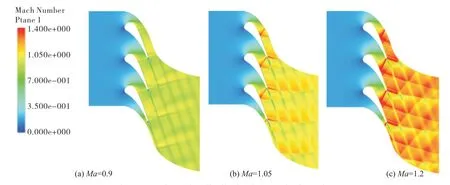
Fig.4 Mach number distribution in cascade channel
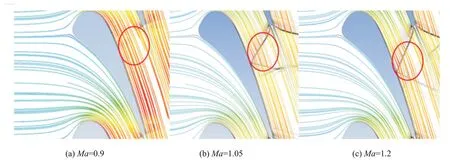
Fig.5 Distribution of wave system in cascade channel
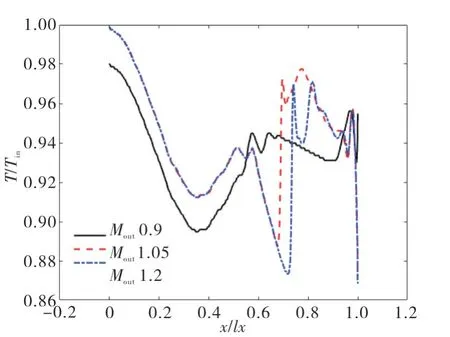
Fig.6 Dimensionless temperature distribution on suction surface of cascade at different exit Mach numbers
3.2 Effects of Different Cold Air Injection Positions on Flow Field and Wall Temperature Distribution in the Channel
The film hole diameter of the comparison scheme in this section is 1mm,the inci-dence angle is 25°,and ratio of cold air pressure to mainstream pressure is 1,but the injection position is different.Figure 7 and Figure 8 show the Mach number distribution and shock system distribution in turbine cascade channel under different cold air injection position schemes (scheme 1: film hole position is 0.6215 times of axial chord length from leading edge,scheme 2: film hole position is 0.6905 times of axial chord length from leading edge,scheme 3: film hole position is 0.7773 times of axial chord length from leading edge).It can be seen from Figure 7 that different cooling gas injection positions have a significant effect on the Mach number distribution in the channel.In scheme 2 and scheme 3,due to the injection of cooling gas,the high-speed flow area near the suction surface in the channel is divided into two parts by cooling gas,and the area of different parts of the injection position is significantly different.It can be seen from Figure 8 that there are obvious differences in the distribution of wave system in the channel under different schemes of cooling gas injection position.There is a strong incident shock wave and a weak reflection wave on the suction surface of injection position 1;In scheme 2,because the incident position of the cooling gas is close to the incident point of the shock wave,the interaction between the cooling gas and the shock wave is strong,and the wave system in the channel is complex;In scheme 3,the cooling gas is injected into the rear of the shock wave incidence position.It can be seen that the interaction between the cooling gas,the expansion wave at the opening position and the reflected wave makes the reflected wave enhanced.
Figure 9 shows the influence of the cooling gas injection position on the temperature of the suction surface of the turbine cascade.The results show that the location of the film hole on the suction surface has a significant effect on the temperature of the suction surface of the turbine cascade while keeping the cooling gas at the same injection pressure and the same incidence angle.The improvement of the wall temperature downstream of the film hole is more obvious in scheme 1 than in scheme 2 and scheme 3.
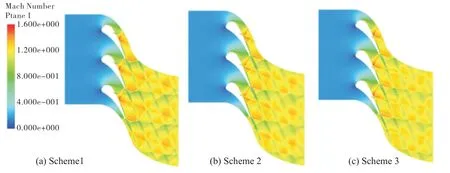
Fig.7 Effect of cold air injection position on Mach number distribution in cascade channel
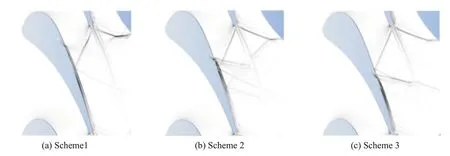
Fig.8 Effect of cold air injection position on wave system distribution in cascade channel
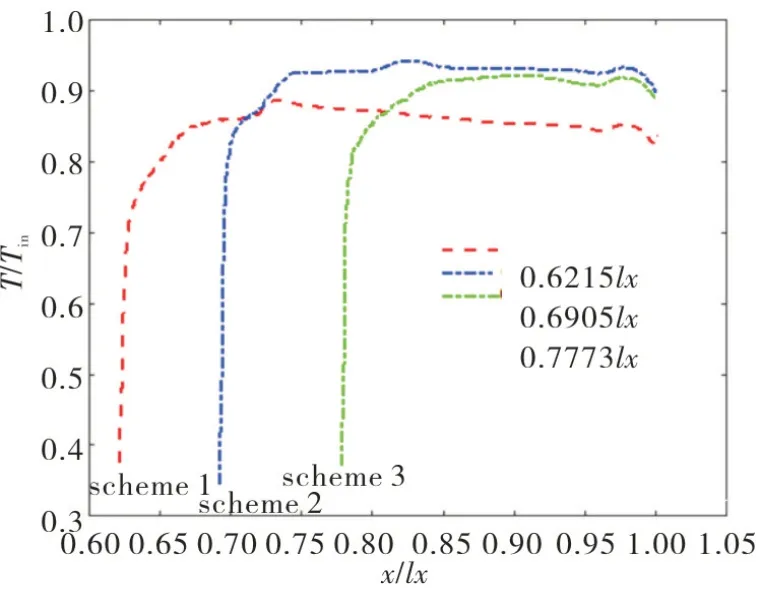
Fig.9 Effect of cold air injection position on dimensionless temperature distribution on suction surface of cascade
Figure 10 is a combined diagram of the structure of the wave system and the dimensionless temperature of the suction surface in the cascade channel under different cooling gas injection positions.It can be seen from the diagram that the cooling area of the wall at the shock incident position is smaller than that before and after the shock incident,which is mainly due to the high-speed mainstream impinging on the gas film at the shock incident position.The results show that the film coverage area under the shock wave is reduced by the impact damage,and the cooling film reattaches after the high-speed mainstream impact area under the compression of the main-stream,which resulting in the discontinuous film coverage at the shock wave incidence point.
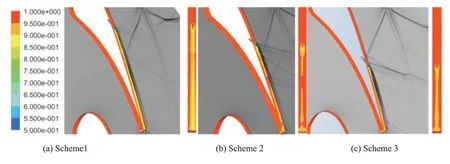
Fig.10 Effect of cold air injection position on temperature cloud image distribution on suction surface
3.3 Effects of Different Cold Air Injection Pressure on Flow Field and Wall Temperature Distribution in the Channel
The film hole diameter of the comparison scheme in this section is 1mm,the incidence angle is 25°,and film hole position is 0.6215 times of axial chord length from leading edge,but the injection pressure is different.Figure 11 and Figure 12 are the comparison of Mach number distribution and shock wave shape under different cooling gas injection pressure.It can be seen from the figure that with the increase of cooling gas injection pressure,the Mach number distribution in cascade channel has little change;It can be seen from the figure that there is a reflected wave behind the shock incident point when the cooling gas injection pressure is small,but with the increase of the injection pressure,the reflected wave gradually weakens and disappears.

Fig.11 Effect of cold air injection pressure on Mach number distribution in cascade channel

Fig.12 Effect of cold air injection pressure on shock wave distribution in cascade channel
Figure 13 and Figure 14 show the comparison of centerline dimensionless wall tem-perature and dimensionless wall temperature distribution under different injection pressures.Under different injection pressures.Under different injection pressures,the temperature near the cooling hole is the lowest,and the wall temperature increases with the increase of the distance from the cooling hole;when the injection pressure is 0.6 times the total inlet pressure of the main stream,the wall temperature downstream the cooling hole is lower than the other two injection pressure schemes,which indicates that there is an optimal value of the injection pressure from 0.5 times the total inlet pressure of the main stream to 1 times the total inlet pressure of the main stream.If the injection pressure of cooling gas is too low,the film formed on the turbine cascade wall is less,and the cooling effect is poor.If the injection pressure of cooling gas is too high,the momentum of cooling gas is too large,most of the cooling gas penetrates into the main-stream,and the film formed on the turbine cascade wall is less.In the design process,the injection pressure of cooling gas should be reasonably determined according to the opening position of film hole.
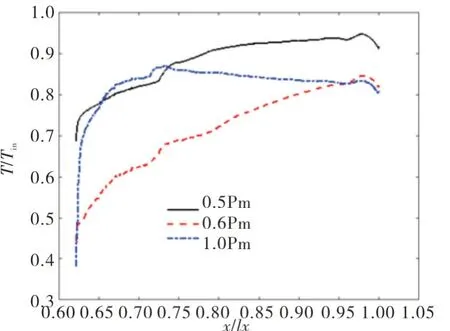
Fig.13 Effect of cold air injection pressure on dimensionless temperature distribution on suction surface of cascade

Fig.14 Effect of cold air injection pressure on dimensionless temperature cloud image distribution on suction surface
3.4 Effects of Different Film Hole Angles on Flow Field and Wall Temperature Distribution in the Channel
The film hole diameter of the comparison scheme in this section is 1mm,the ratio of cold air pressure to mainstream pressure is 1,and film hole position is 0.6215 times of axial chord length from leading edge,but the incidence angle is different.Figure 15 and Figure 16 show the Mach number distribution and wave system structure in the channel with different film hole angles.It can be seen from the figure that there is no significant difference in Mach number distribution and wave system structure in the channel with different film hole angles.
Figure 17 and Figure 18 show the comparison of centerline wall temperature and wall temperature distribution under different film hole angles.It can be seen from the figure that the cooling effect of turbine cascade wall is the best when the film hole angle is 25°and the cooling effect gradually weakens with the increase of the incidence angle.When the incident angle increases from 35°to 45°,the wall temperature far away from the film hole does not change much,and the cooling effect is not significantly affected.The main reason is that with the increase of the incident angle,the depth of the cooling air penetrating into the mainstream increases,and the wall adhesion of the cooling gas becomes worse.However,the cooling effect of the cooling gas far away from the film hole does not change much.The main reason is that under a certain blowing ratio,the momentum of the cooling gas penetrating through the mainstream is limited,and a part of the cooling gas forms a film on the wall under the pressure of the mainstream.
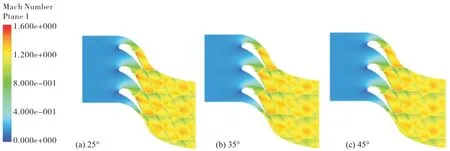
Fig.15 Effect of incident angle of film hole on Mach number distribution in cascade channel

Fig.16 Effect of incident angle of film hole on wave system distribution in cascade channel
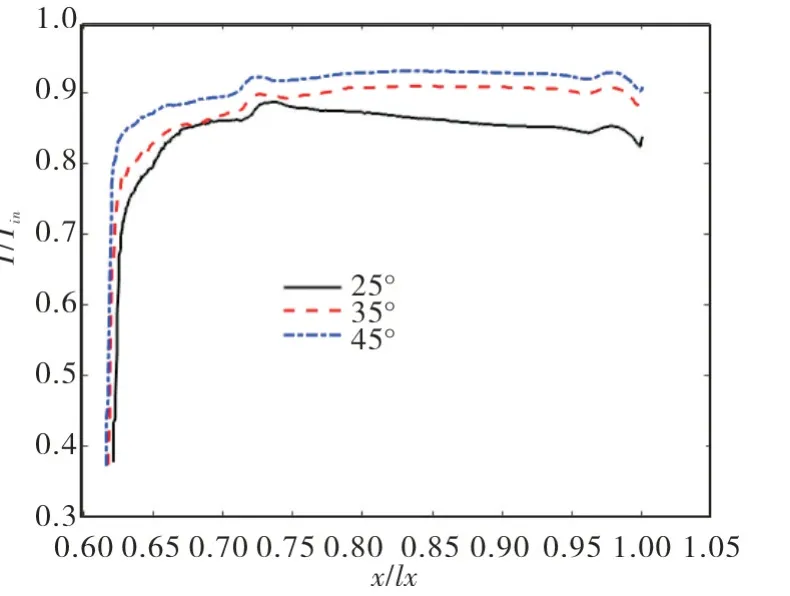
Fig.17 Effect of incident angle of film hole on dimensionless temperature distribution on suction surface of cascade
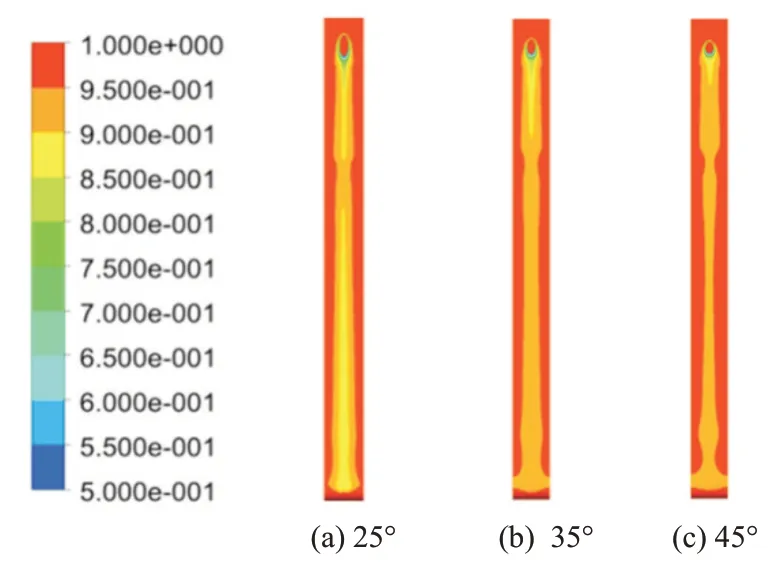
Fig.18 Effect of incident angle of film hole on dimensionless temperature cloud image distribution on suction surface
4 Conclusions
1) With the increase of exit Mach number,the incident position of the left shock moves backward relative to the leading edge of the cascade,and the shock intensity increases.The results show that there is a temperature jump behind the temperature peak at the exit Mach number of 1.05 and 1.2.The main reason is that with the increase of shock wave intensity,the interaction between shock wave and boundary layer intensifies,and the boundary layer appears local separation.In the separation region,the mixing of high temperature mainstream and boundary layer flow intensi fies,which makes the temperature of the separation region of suction surface increase.
2) The results show that different cooling gas injection positions have great influence on the shock wave shape in the channel,and the cooling area of the wall is smaller than that before and after the shock wave,which is mainly due to the impact damage of the film coverage area under the shock wave at the shock wave incidence position.After the shock zone,the cooling film reattaches under the pressure of the main stream,resulting in the discontinuous film coverage at the shock incident point.
3) There is an optimal value of the injection pressure from 0.5 times the total inlet pressure of the main stream to 1 times the total inlet pressure of the main stream.
4) The film cooling efficiency decreases significantly with the increase of cooling flow angle from 25° to 35° and changes little with the increase of cooling flow angle from 35°to 45°.

